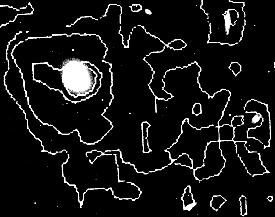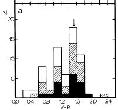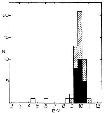


5.2. The evolution of galaxies in clusters
The importance of collisions for the evolution of cluster galaxies was understood quite early. Since a cluster of galaxies is a dense environment, ``collisions must necessarily enter as a factor in the evolution of the system'' (Shapley [417], 1935). In 1937 Zwicky [513] imagined that collisions might lead to the disruption of certain types of nebulæ, which could explain why the morphological mix of cluster galaxies is different from the field. The first observational evidence for this effect came only thirty years later, when Reaves [368] found that dwarf galaxies avoid the cluster centres.
In 1943 Chandrasekhar [103] developed his theory of ``dynamical friction'', ``the systematic decelerating effect of the fluctuating field of force acting on a star in motion''. Chandrasekhar derived his formula on the basis of the two-body approximation for stellar collisions. More than thirty years later, with the discovery of massive halos around galaxies, Lecar [277] suggested that galaxies gradually settle to the cluster centres by dynamical friction through a sea of tidally-stripped galaxy halos. The validity of Chandrasekhar's formula was confirmed through numerical simulations by White [492, 493].
In 1940 Holmberg [225] had remarked that spirals must transform into ellipticals, if clusters form by the capture of field galaxies. Spitzer & Baade [430], in 1951, were the first to suggest collisions as a mechanism to transform a galaxy type into another. They thought that collisions would affect primarily the gas content of a galaxy, and not so much its stellar structure, leading to the formation of irregular galaxies. A year later Zwicky [521] found evidence for intergalactic matter in small galaxy groups, and attributed it to material stripped from galaxies during close encounters. This was confirmed 20 years later by the simulations of Toomre & Toomre [462]. Spitzer & Baade's analysis was revised twice between 1963 and 1965. First Aarseth [1] revised downward Spitzer & Baade's estimate of the number of galaxy-galaxy collisions, as a consequence of the revised distance scale. Then, Alladin [26] revised upwards Spitzer & Baade's estimate of the internal energy change of a galaxy during a collision.
In 1970 Tinsley [460] developed her theory for the evolution of the spectral energy distribution of galaxies and showed that strong evolutionary corrections were to be expected for the colours of ellipticals, because of the aging of the stellar population (13). The following year, Oke [334] devised to compare the colours of nearby and distant cluster ellipticals with evolutionary models, and thus infer their (photometric) redshifts.

|
Figure 32. Contours of X-ray emission around the galaxy M 86 in Virgo. The extended emission was interpreted as evidence for ram pressure stripping of hot gas from the galaxy. From Forman et al. (1979). |
In 1972 Rood et al. [385] noticed that the Coma cluster S0s were not confined to the cluster core, where collisions were expected to be most effective, and questioned the validity of the collision model for the formation of lenticular galaxies. In the same year, Gunn & Gott [200] and Larson [268] presented two alternative models for the evolution of galaxy morphologies. Gunn & Gott proposed ram pressure stripping of the interstellar gas by the hot IC medium as a mean of transforming spirals into S0s. The first direct observational evidence of such an effect came seven years later, with Forman et al. [166]'s X-ray observations of the Virgo galaxy M 86 - see Fig. 32. Larson, on the other hand, suggested a relation between the morphological type of a galaxy, and the collapse time of the gas during galaxy formation. Galaxies with a short collapse time would have their material used up early, leading to old stellar populations and little gas left (like in ellipticals and S0s). The morphology-density relation could then follow by relating the collapse time to the ambient density. According to Oemler [331], the ``birthrate of elliptical galaxies [...] increases with density relative to the other galaxy types'', and collisions may be sufficient to transform spirals into S0s but not into ellipticals. Larson's ideas were later developed by Gott & Thuan [190].
In 1975 Biermann & Tinsley [61] remarked upon the similarity of the colours of ellipticals and S0s. This implies that ellipticals and S0s have similar stellar populations, and therefore similar old ages, so that a recent transformation of spirals into S0s is out of question. The issue is certainly not closed, with independent evidences in favour [154] and against [146] an ancient origin of S0s.
In 1976 White [491]'s n-body simulations showed that the formation process of a cluster leads to an increasing ellipticity of galaxy orbits with clustercentric radius, i.e. radial motions are predominant in the outer cluster regions. The observations of Moss & Dickens [313] seemed to confirm White's findings. Moss & Dickens observed that late-type galaxies have a higher velocity dispersion than early-types, and interpreted it as an evidence for an infalling population of field galaxies into the clusters. Recently Biviano et al. [71] have shown that emission-line galaxies in clusters are characterized by predominantly radial orbits. A thorough determination of the orbits of different types of cluster galaxies, through the solution of the Jeans equation, is in preparation [72].
White [491, 492]'s simulations also showed that a marginal mass segregation can establish in clusters through dynamical friction. Merging of the slowed-down galaxies would then follow in the cluster core, eventually with the formation of a cD galaxy (see Section 5.4). Struble [437]'s observation of a low velocity dispersion in the core of some galaxy clusters was taken as supporting evidence for these effects. A few years later Roos & Aarseth [389] re-examined the issue of mass segregation by running n-body simulations of a galaxy system with a Schechter-like distribution of galaxy masses. They noted that segregation establishes in subclusters before these merge to form the final cluster. Segregation is then conserved while the cluster evolves, because tidal stripping predominantly affects the outer regions of subclusters. Such an evolutionary scenario was found to be consistent with Capelato et al. [91]'s observations of luminosity segregation in Coma, and with recent analyses of the Coma cluster structure [300, 68].
In 1980 Dressler [142] noted that ram-pressure stripping could not account for the different bulge-to-disk ratios of spirals and S0s. Richstone [373] and Marchant & Shapiro [291] had already shown that collisions of spirals can fatten the galaxy disks, so that Dressler's observation was not a problem in the collision scenario. Farouki & Shapiro [161]'s simulations showed however that also the ram-pressure mechanism would lead to a thickening of the galaxy disks. Finally, in 1982 Nulsen [330] noted that other interaction mechanisms between cluster galaxies and the hot IC gas medium (viscosity, thermal conduction, turbulence) could be even more effective than ram-pressure in stripping gas from galaxies.
In 1980, Larson et al. [270] noted that if star formation continued in galaxy disks at the rate determined in the local Universe, spirals would run out of gas in a relatively short time. Disk replenishment of gas is therefore needed. An early generation of spirals, formed in high density regions, would be characterized by small disks, and such spirals could evolve into nowadays S0s by the loss of their gaseous halos through collisions. According to Roos & Norman [390]'s n-body simulations, ellipticals could instead form via mergers during the early stage of cluster collapse, before the dispersion of galaxy velocities becomes too high.

| 
| 
|
Figure 33. The V-R colour distribution of galaxies in the cluster Cl0024+1654 (left), and in the cluster 3C295 (middle). Different shadings correspond to subsamples of galaxies at different distances from the cluster centres. The B-V distribution of galaxies in the Coma cluster (right). Solid area: ellipticals; hatched area: S0s; remainder: spirals. From Butcher & Oemler (1978a). | ||
All these theoretical efforts to determine the evolution of galaxies
received a formidable acceleration with the first direct observational
evidence for the evolution of the cluster galaxy population. In 1978,
Butcher & Oemler
[85]
published the first of a series of
papers on The evolution of galaxies in clusters. Their
photometric observations of two regular, centrally concentrated,
z  0.4 clusters, showed
an excess of blue galaxies, as compared
to nearby rich clusters - see Fig. 33.
Butcher & Oemler
[85,
86] noted
that such a high fraction of blue galaxies was more typical of nearby
poor irregular clusters like Hercules. They later confirmed their
finding through photometric observations of seven more clusters at
redshifts beyond 0.2 (Butcher et al.
[87]).
0.4 clusters, showed
an excess of blue galaxies, as compared
to nearby rich clusters - see Fig. 33.
Butcher & Oemler
[85,
86] noted
that such a high fraction of blue galaxies was more typical of nearby
poor irregular clusters like Hercules. They later confirmed their
finding through photometric observations of seven more clusters at
redshifts beyond 0.2 (Butcher et al.
[87]).
Butcher & Oemler's result was greeted with much scepticism. Even before Butcher & Oemler's paper was published, Baum (in the discussion following a talk of Spinrad [429]) suggested that their result could be due to contamination by field galaxies. Koo [262] imaged another distant cluster, where he did not find evidence for the Butcher-Oemler effect. Mathieu & Spinrad [294] re-examined the fraction of blue galaxies in one of Butcher-Oemler clusters, and showed it to be much lower than originally estimated. Lucey's critical ``assessment of the completeness and correctness of the Abell catalogue'' led him to conclude that the Butcher-Oemler effect was due to an erroneous assignment of cluster membership.
Theorists were however not discouraged by potential observational biases. In the models of Norman & Silk [329] and Himmes & Biermann [218] the IC gas gradually build-up from the gas stripped through collisions of cluster galaxies. Norman & Silk [329] noted that such a gradual built-up of the IC gas can delay the effectiveness of ram-pressure stripping until z ~ 0.5. If ram-pressure transforms spirals into S0s, this would explain the excess of spirals in high-redshift clusters. However, Henry et al. [212]'s X-ray observations showed the existence of a dense IC medium in one of the clusters showing the Butcher-Oemler effect.
In 1982, 1983, Dressler & Gunn [144,145] finally performed spectroscopic observations of galaxies in Butcher-Oemler clusters. The fraction of blue galaxies which are cluster members was found to be lower than predicted by Butcher & Oemler, but still higher than in nearby rich clusters. The Butcher-Oemler effect was confirmed.
More than twenty years after the original discovery, the Butcher-Oemler effect is well established (see ELLINGSON, MARGONINER, these proceedings), and a considerable progress has been made in determining the nature of the excess blue galaxies (see, e.g., Poggianti et al. [361]). The physical mechanisms responsible for the evolution of cluster galaxies are not yet determined with certainty, but it is likely that collisions, as initially suggested by Shapley [417], are of fundamental importance (see MOORE, KAUFFMAN, LANZONI, these proceedings).